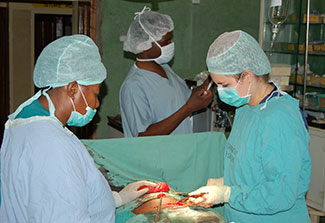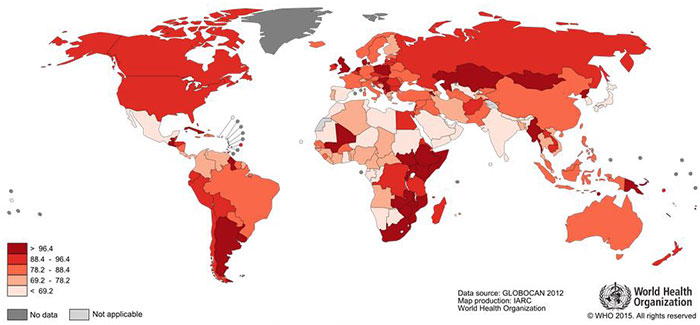Focus on cancer: Research, technology fight cancer in LMIC women
July / August 2018 | Volume 17, Number 4

Photo courtesy of Krista Pfaendler
By supporting innovative research to detect cancers in
women in low-resource settings, more cases can be
diagnosed and referred for treatment, including surgery.
women in low-resource settings, more cases can be
diagnosed and referred for treatment, including surgery.
By Karin Zeitvogel
Nearly 90 percent of global deaths from cervical cancer and 60 percent of breast cancer mortalities occur in low- and middle-income countries (LMICs), where a lack of screening means many women present with advanced-stage disease.
“In Africa, where I do research, cancer is more common in women than men,” said Dr. Clement Adebamowo, director for global health cancer research at the University of Maryland Medical School. “Over 60 percent of cancer cases in Africa are in women.” Under the Human Heredity and Health in Africa (H3Africa) initiative, Adebamowo is studying the association between environmental, microbiomic, genetic and epigenetic factors, and HPV infection, and using molecular biology methods to characterize breast cancer tumors in thousands of Nigerian women. Fogarty, the National Human Genome Research Institute (NHGRI), and the NIH Common Fund provide NIH leadership on H3Africa.
To reduce “genomics noise” - defined by Adebamowo as the deviation you see when you mix Africans from one country on the continent with another, or with Africans in the Caribbean and African Americans - Adebamowo is studying women from a defined area near the Nigerian capital. “People have said African women are uniquely predisposed to having poor prognostic tumors,” said Adebamowo. “With our large sample size and new technology, we hope to be able to confirm that or lay it to rest once and for all.”
With her Fogarty International Research Scientist Development Award (IRSDA), Dr. Tomi Akinyemiju of the University of Kentucky is investigating whether the three-fold increase in breast cancer incidence in Nigeria over the past 40 years is linked to higher rates of obesity, hypertension and diabetes.
In Zambia, a project supported by Fogarty and the National Cancer Institute (NCI) used low-cost visual inspection with acetic acid, mobile technology and task-shifting to screen more than 100,000 women for cervical cancer. Seven women per 1,000 were found to have invasive cervical cancer. Women with HIV were more likely to show signs of precancer or cancer than those without the virus.
Reverse innovation
Scientists in Uganda have been able to study large cohorts of individuals with cancers that are relatively rare in the United States but common in East Africa, including Kaposi Sarcoma, Burkitt Lymphoma and triple negative breast cancer. “The burden of disease and types of diseases in Uganda afford us an opportunity for reverse innovation - to see whether a diagnostic or therapeutic intervention developed in LMICs could also be used to treat patients in the U.S. more effectively,” said Dr. Corey Casper of the University of Washington and Fred Hutchison Cancer Research Center, which partnered with the Uganda Cancer Institute to train hundreds of physician-scientists, nurses, lab technicians and other cancer care-providers with Fogarty support.
Casper has also been gaining insight into immunotherapy by investigating tumor-infiltrating lymphocytes in cervical cancer in Ugandan patients, with funding from NCI. “We couldn’t do this research in the U.S.,” said Casper. “It’s only possible because of the high prevalence of HIV and cervical cancer in Uganda, which allows us to study the relationship between the immune system and cancer in-depth.”
Estimated Cancer Mortality Worldwide in 2012: Women
Source: Globocan Cancer Fact Sheets
Map description: World map shows the estimated cancer mortality of women in 2012 using the estimated age-standardized rates per 100,000. See full data from the Globocan Cancer Fact Sheets .
More Information
- Population-level scale-up of cervical cancer prevention services in a low-resource setting: Development, implementation, and evaluation of the cervical cancer prevention program in Zambia
PLoS One, April 17, 2015 - Stage at diagnosis of breast cancer in sub-Saharan Africa: a systematic review and meta-analysis
The Lancet Global Health, December 2016 - Efforts towards erasing borders in gynecologic cancer?
Gynecologic Oncology Reports, August 2017 - Cohort profile: African Collaborative Center for Microbiome and Genomics Research’s (ACCME's) human papillomavirus (HPV) and cervical cancer study
International Journal of Epidemiology, December 2017 - Closing the breast cancer divide in sub-Saharan Africa
Fred Hutchinson Cancer Research Center news, August 15, 2017 - Burden of cancers attributable to infectious agents in Nigeria: 2012–2014 [Open access]
Frontiers in Oncology, October 24, 2016 - A prospective study of obesity, metabolic health and cancer mortality among blacks and whites
Obesity (Silver Spring), January 2018 - Factsheet on breast cancer from Globocan
- Factsheet on cervical cancer from Globocan
- Related grants:
- About Dr. Clement Adebamowo’s research supported by H3Africa
- Dr. Adebamowo Fogarty-supported research:
- Entrenching Training and Capacity in Research Ethics in Nigeria (ENTRENCH) Program and West African Bioethics Training Program, both supported by NHGRI and Fogarty through Fogarty's International Bioethics Training program
- Capacity Development for Research into AIDS-Associated Malignancies (CADRE), supported by NCI and Fogarty
- Cancer in Africa, supported by Fogarty's Framework Program for Global Health
- Training Program in Nigeria for NCD Research (TRAPING-NCD), supported by Fogarty's Chronic, Noncommunicable Diseases and Disorders Research Training program
- Dr. Tomi Akinyemiju's project Metabolic Syndrome and Epigenetic Markers of Breast Cancer in Nigerian Women, supported by Fogarty's International Research Scientist Development Award (IRSDA)
- Dr. Corey Casper's projects supported by NCI and Fogarty:
Building Sustainable Translational Research Teams in HIV-Associated Malignancies
Biologic Determinants of the Natural History of AIDS-Defining Cancers in Uganda
To view Adobe PDF files, download current, free accessible plug-ins from Adobe's website .






















.png)









No hay comentarios:
Publicar un comentario